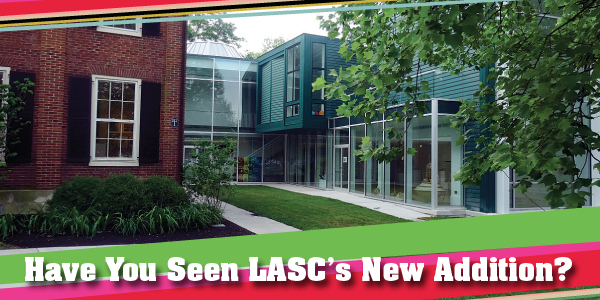Have You Seen LASC’s New Addition?
Have You Seen LASC’s New Addition?
Expansion Doubles Space, Transforms Experience for Visitors
 By John Lynch
By John Lynch
How do you know that an educational center is a huge hit? When children don’t want to leave when it’s time to go.
That was the case at the grand opening of the Living Arts & Science Center in May when more than 1,000 people streamed though the gleaming new addition to the venerable establishment in downtown Lexington.
Kathy Regan, a grandmother of two and the former director of Providence Montessori School, was wowed by the new addition like everyone else who visited that day.
“When it was time to go, my oldest granddaughter protested, saying we hadn’t seen everything yet,” Regan said. “She even started crying.”
Regan could understand why. As a parent she brought her children to the Center, and as an educator she witnessed the benefits Providence students enjoyed from LASC’s hands-on, experiential classes and programs.
“I have always been impressed with how they make science fun,” Regan said.
“And their programs are geared to the needs of children. You can tell they have put a lot of thought into what they do.
“And now they have so much more room for everything.”
That’s why the expansion was a necessity, according to Heather Lyons, LASC’s executive director for 11 years.
“This expansion is not just about wanting a nice, beautiful building. We desperately needed the room,” she said.
“We were turning people away, and the demand for our programs kept growing.”
The $5.5 million expansion, which more than doubled the Center from 7,000 to 18,500 square feet, is nothing short of transformational for LASC.
The lustrous, modernistic addition adjoined to the historic building ideally blends old and new to establish a downtown landmark.
It’s also a far cry from LASC’s beginnings, in 1968, when director Jim Seidelman operated out of the trunk of his car.
Three years later, LASC moved into the Kinkead House on Martin Luther King Boulevard, which has housed LASC since.
LASC squeezed its offices, two galleries and four upstairs classrooms into the building. The limited space spawned, shall we say, creative solutions.
“We put up cardboard doors in the galleries to create classrooms,” Lyons said. “That’s why we could never have field trips in the summer.
“Our planetarium was portable and would take up a whole room when we set it up.”
Now, LASC has the city’s only planetarium along with spacious classrooms with floor-to-ceiling windows overlooking that ground that include a waterscape, rain gardens and Kentucky native trees.
The new space includes: the Discovery Gallery (currently housing a space exhibit) and the Glo Gallery (named for long-time supporter Gloria Singletary), which is a double-height space featuring a 40-foot screen where videos can be seen inside and outside simultaneously.
The addition also includes a clay studio, digital media lab, teaching kitchen, innovation lab, makers space, two classrooms and a rooftop garden.
“Not only can we add new programs, this has allowed our existing programs the room to grow,” Lyons said.
For first time, LASC serves as a real museum and art gallery where people can take self-directed tours for free on weekdays (8:30-5:30) and pay $4 on Saturdays for planetarium shows and teacher-led activities in the makers space and Discovery Gallery.
LASC is known for its year-round offerings for kids, teens and adults of more than 300 eclectic, interactive classes that embrace art and science.
During the school year, LASC offers classes on no-school days, spring break and holidays.
This summer, LASC has scheduled 135 unique classes – everything from ceramics and photography to bugs, slugs and dream house construction – that will serve more 1,100 children. Next summer, Lyons expects those numbers to reach 160 classes and 1,500 kids.
That’s kids of all kinds from all over the Bluegrass.
“The Center has always been diverse,” said Tanya Finley, whose daughter Jade, 16, has attended classes since she was 4. Jade now volunteers at the LASC.
“There are people of different races and ethnicities from all over the city here.”
And all ability levels. Jade, for instance, has autism.
“I credit her improvement to having a place at the Center to express herself,” Tanya Finley said. “I’m in awe of what they do here.”
That’s a common sentiment among LASC supporters. Stacie Marksbury first appreciated the Center as a substitute teacher.
“The students just loved their field trips to the Living Arts & Science Center,” she said.
Later, when her husband mentioned that his family’s non-profit, the Marksbury Family Foundation, had been approached by LASC fund-raisers, his wife convinced the Foundation to contribute. (The Discovery Gallery is named for the Foundation).
“I knew the Center was a wonderful place, and I knew that they had no space,” Stacie Marksbury said.
“I’m just blown away by everything that the expansion has given the Center. It’s like a dream come true for them.”
LASC need dream no longer. If you haven’t visited the expanded Center, it’s a crying shame.

Photo: LASC’s $5.5 million addition has expanded its space to 18,500 square feet and includes the city’s only planetarium.

